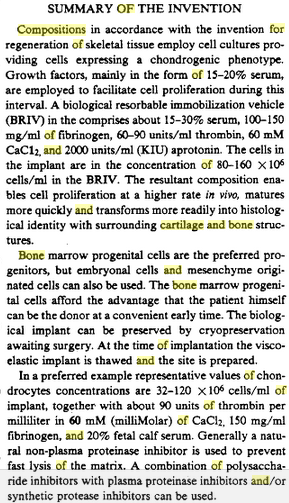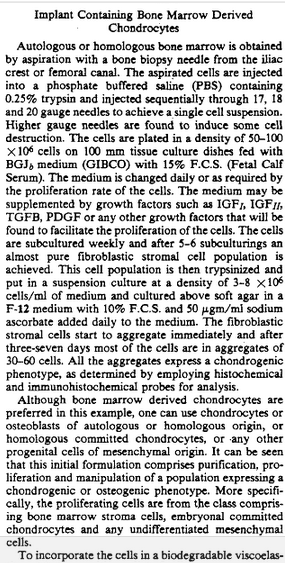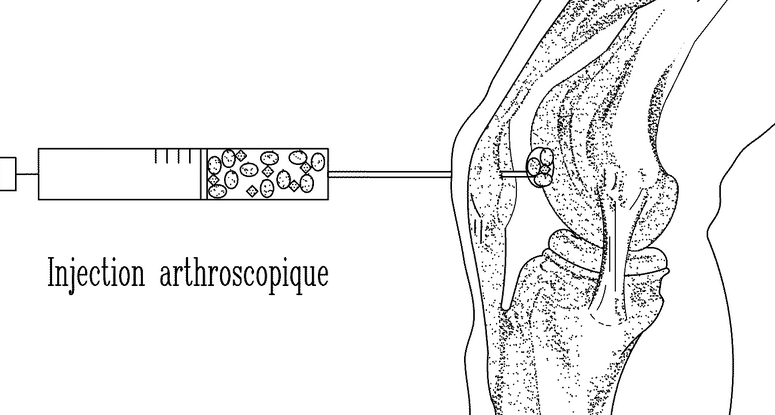Me: This is going to be the start of a proposed idea on how to increase height using a two step process. From a lot of the research, we have already found many, many ways to make bone fractures heal. That part is easy. In addition, we have also found many ways to induce the creation of chondrocytes from some form of external stimuli, whether chemical, mechanical, electrical, to cause the right type of differentiation in progenitor cells. Let’s assume first that because the inorganic compound in bones, the Hydroxylapatite (Calcium & Phosphorous element combination) which causes the bone to have it’s intrinsic quality of being so tough and hard, with a compressive and tensile strength in the level of stainless steel. Let’s say for argument that if the hypertrophy of chondrocytes in the epiphysis was not enough to cause long bone lengthening through hydrostatic pressure and expansion of the trabecular and cortical bone, we would then need to find another way to cause the hard bone to separate, at least long enough for chondrocytes and cartilage to get between the hard inorganic spaces to push them apart. This is way I have almost always believed that besides the LSJL method which seems promising, there may be no way to cause adult height increase in a non-invasive way. I thought that a bone distraction or fracture was needed. However, after going through the literature recently I have concluded instead that maybe it is possible if we can use some form of process to demineralize the Hydroxylapatite from the bone matrix at a level where the tensile strength of the bone is dramatically decreased. I remember reading from HeightQuest that Tyler suspected that the Ginza Kojima machine operated on this principle where the green light emitted or the chemical bath used was to somehow demineralize the bone and give it a lower young’s modulus value. Then a torsional or twisting load was made to the bone since the torsional loading value of long bones with the cortical bone was not that high. From what Tyler, Sky, and I have seen the machine has been around on the market for many years now with little news or press placed on it. In my opinion, mineralization may be a key step that might be required to be added on for the entire height increase technique to work. There might indeed be a step where limbs are subjected to some form of chemical, electrical stimuli, or other to weaken the bones a little.
Analysis: In the study the researchers used a suitable method for rapid demineralization of mouse teeth in 0.1 M (molar) EDTA (ethylene diamine tetra-acetic acid) at 42˚C . From the study the mice were eventually killed to study the bone mineralization so obviously this type of testing can’t be done on human subjects but the major take away should be that we can try these methods where the subject’s limb is placed in a weak acid mixture, have the heat increased, (maybe not as high as 42 C) and slowly over time have the bones demineralized for possible tensile loading later. It has already been reported that bone demineralization was accelerated by microwave treatment to heat the subjected bone up and increased the rate of dimeralization by 2X, or at least with tested mice skulls. In the study, the researchers showed that there are plenty of stronger acids out there that can do the demineralization work a lot better and faster but that woudl destroy the genes and gene expression of the underlying body tissue, which would include for a live human subject muscle and bone and ligaments. We obviously want to avoid that. It would require more research to find a better acid solution that can extract bone minerals while keeping most other tissues safe and intact.
Overall, this is my first crude attempt at trying to find a way to dimineralize the bones. I would suspect for future testing, it may be a better idea to focus on just a small 4-5 mm thick layer of axial directional bone and try to dimineralize that. area. If that that process is successful, we can either induce chondrocytes to replace those areas where the hydroxylapatite was or increase the activity of osteoclasts to remove the bone material for growth factors and progenitor chondrogenetic cells.
From source link HERE…
A Method for Rapid Demineralization of Teeth and Bones
Andrew Cho, Shigeki Suzuki, Junko Hatakeyama, Naoto Haruyama, and Ashok B. Kulkarni
Abstract: Tooth and bone specimen require extensive demineralization for careful analysis of cell morphology, as well as gene and protein expression levels. The LacZ gene, which encodes the ß-galactosidase enzyme, is often used as a reporter gene to study gene-structure function, tissue-specific expression by a promoter, cell lineage and fate. This reporter gene is particularly useful for analyzing the spatial and temporal gene expression pattern, by expressing the LacZ gene under the control of a promoter of interest. To analyze LacZ activity, and the expression of other genes and their protein products in teeth and bones, it is necessary to carry out a complete demineralization of the specimen before cutting sections. However, strong acids, such as formic acid used for tooth demineralization, destroy the activities of enzymes including those of ß-galactosidase. Therefore, most protocols currently use mild acids such as 0.1 M ethylene diamine tetra-acetic acid (EDTA) for demineralization of tooth and bone specimen, which require a longer period of treatment for complete demineralization. A method by which hard tissue specimens such as teeth and bones can be rapidly, but gently, decalcified is necessary to save time and effort. Here, we report a suitable method for rapid demineralization of mouse teeth in 0.1 M EDTA at 42˚C without any loss of ß-galactosidase activity.
INTRODUCTION
Teeth are the hardest tissues in the body, consisting of enamel, dentin, and cementum, and have a highly mineralized extracellular matrix. Unlike soft tissues, which can be easily sectioned and analyzed, teeth require complete demineralization in order to prepare proper sections for histological
analysis using certain stains and antibodies. In the past, many decalcifiers have been tested for different purposes. For example, the Morse’s solution, a strong acid baseddecalcifier, has been used for the rapid detection of RNA by in-situ hybridization (ISH) [1]. Another acid-based solution,
5% trichloroacetic acid (TCA), has been used for the analysis of DNA strand breaks by terminal deoxy (d)-UTP nickend labeling (Tunnel) [2]. EDTA containing solution is a mild demineralization agent which has been mostly used for immunolocalization studies because of its antigen-preserving
properties. Treatment of bones with 0.1 M EDTA following initial fixation in glutaraldehyde has been reported as adequate for immunocytochemical localization of certain bone matrix proteins [3]. Furthermore, the treatment of dental tissues with 4.3% EDTA resulted in satisfactory preservation of the fine structures of the cells and matrices [4], however it requires a relatively long incubation time in order to achieve complete demineralization [5,6]. For example, to demineralize human deciduous teeth for analysis, it requires 4 weeks of demineralization using 10% EDTA [7]. To demineralize a 1-month-old mouse skull with similar EDTA solution it takes about 3-4 weeks of treatment to prepare the specimen for analyzing expression levels of the LacZ and growth fac
*Address correspondence to this author at the Chief, FGS, CDBRB, NIDCR, NIH, Tel: 301-435-2887; Fax: 301-435-288; E-mail: ak40m@nih.gov tor genes [8,9].
To achieve fast demineralization, a microwave-induced demineralization method has been examined [10,11]. While this method has achieved faster demineralization time compared to the traditional method, preserved the fine morphological structures of the bone tissue, and retained RNA, its effect on LacZ gene expression has not been addressed. Moreover it has been speculated that the advantages associated with using the method are due to the higher temperature attained during microwaving the specimen purely due to thermal effect [12]. The LacZ gene is widely used to investigate promoter activity [13-15], however there is not detailed protocol for optimal analysis of ß-galactosidase activity in decalcified mouse teeth and bones. Moreover, the effects of acid-based decalcifiers and different fixatives used for preparation of mouse teeth specimen to analyze ß-galactosidase activity have not been well established. In this report, we demonstrate the effects of several fixatives and decalcifiers on mouse teeth specimen for LacZ activity, whose expression is driven by a tooth specific DSPP (Dentin Sialophophoprotein) promoter. Most importantly, we have explored the effects of elevated temperatures on mouse teeth specimen to optimize a rapid but gentle demineralization method suitable for analysis of LacZ activity. This will prove to be a suitable method for rapid demineralization of mouse skulls for analysis using histochemical staining and in-situ hybridization.
DISCUSSION
We set out to optimize the demineralization method in order to make it shorter and safer for histological analysis of mouse teeth. In the process of this optimization, we addressed some of the key issues related to the effects of the decalcifiers and fixatives used for preparing the mouse skull specimen. Our study indicates that the demineralization of mouse skulls at 42°C using 0.1M EDTA can significantly shorten the time required for complete demineralization, while also retaining sufficient ß-galactosidase activity. DSPP, a key dentin extracellular matrix protein secreted by odontoblasts, plays a crucial role in the mineralization of predentin to form mature dentin [18-21]. We previously reported the isolation and characterization of the murine Dspp gene [22] and the validation of its promoter sequence [16]. The Dspp-LacZ transgenic mice used in the present study to display spatial and temporal expression patterns similar to endogenous DSPP expression profiles [16]. In these mice, the LacZ gene, which is placed under the DSPP promoter sequence, is expressed as early as embryonic day 17.5 (E17.5) in preameloblasts and odontoblasts, and at E18.5 in molars. Its expression in preameloblasts is transient, whereas it stays robust in odontoblasts throughout tooth development. Because of this expression profile, the tooth specimens from these mice are ideal for testing the effects of decalcifiers, fixatives and incubation conditions on the stability of ß-galactosidase activity. However, because the LacZ gene, which encodes ß-galactosidase, has been widely used as a reporter gene to analyze the expression of a gene of interest, the demineralization protocol that we have optimized in the current study can be applied to other transgenic mouse models expressing ß-galactosidase in teeth and bones. We first verified the effects of various fixatives and the fixation time on the stability of the ß-galactosidase enzyme in the tooth sections. We tested 0.25% glutaraldehyde, 4% PFA, zinc formalin and formalin for their effects, and found that all of them work well as fixatives to analyze ß-galactosidase activity in the tooth sections (Fig. 1). As for the fixation time, we found that post-incubation of the skulls with 4% PFA for up to an hour did not have any adverse effects on ß-galactosidase activity. However, extending the incubation time to 2 hours adversely affected the enzyme activity (Fig. 2). As previously reported [17], LacZ enzymatic activity in kidney tissue was also retained during a 1- hour incubation time with 4% PFA, but not during a longer period of time.
Next, we tested the acid-based demineralization reagents, Formical-4 and Immunocal, in order to analyze their effects on ß-galactosidase activity. As you can see in Fig. (3), it is clear that 0.1% EDTA, but not the acid-based demineralization reagents, maintained ß-galactosidase enzyme activity after complete demineralization (Fig. 3). Chelating agents such as EDTA can bind to calcium and other ions and remove them from mineralized tissue. This reaction occurs gently, and enzymatic activity can therefore be retained during demineralization. In contrast, long-term exposure to acidic conditions could potentially destroy enzymatic activity such as ß-galactosidase. Another possibility is that, because Formical-4 and Immunocal contain fixatives, ß-galactosidase may be over-fixed and thus result in a lack of enzymatic activity. As shown in Fig. (4), we then explored the potential for shortening the demineralization process by increasing the temperature during demineralization, since it has already been reported that bone demineralization was accelerated by microwave treatment [10,11]. Our data indicated that incubation of mouse skulls with 0.1M EDTA at 42°C results in demineralization that is 2-fold faster than incubation at room temperature. Our data also revealed that, although an incubation temperature of 50˚C can achieve demineralization the shortest incubation time, it adversely affects the enzyme activity (Fig. 5). These data suggest that incubation at 42°C is most useful for analysis of enzymatic activity in decalcified teeth. Moreover, as shown in Fig. (6), 6 days of incubation with 0.1M EDTA at 42°C was sufficient for complete demineralization of 1-year-old mouse teeth. These observations suggest that any specimens can be demineralized by incubation with 0.1M EDTA at 42°C for 6 days.
To assess the effects of elevated temperatures on the stability of nucleic acids, we extracted total RNA from the tooth sections of the skulls subjected to different temperatures for the demineralization process, and performed RTPCR analysis. The amplification of Gapdh mRNA transcripts at 37°C, 42°C or 50°C showed similar levels, indicating that a higher temperature had no affect on the stability of nucleic acids (Fig. 7).
In summary, we have optimized the conditions for rapid demineralization of mouse skulls, which significantly shortens the time required for complete demineralization but does not affect the enzyme activity or nucleic acids in the tooth sections. We recommend 0.1M EDTA as a safe decalcifier, to be used at 42°C for successful demineralization of mouse skulls. These conditions could be widely applied for the enzymatic and immunohistochemical analysis of other proteins in hard tissues. Moreover, rapid demineralization using this method will promote quicker analysis of genes and proteins implicated in tooth and bone diseases.
ACKNOWLEDGEMENTS
We would like to thank Dr. Taduru Sreenath for his helpful suggestions during the course of this project. We also would like to thank Drs. Marian Young and Larry Fisher for critical reading of the manuscript, and Shelagh Powers for expert editorial corrections. This work was supported by funds from the Division of Intramural Research of the National Institute of Dental and Craniofacial Research.



